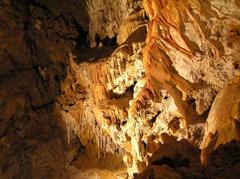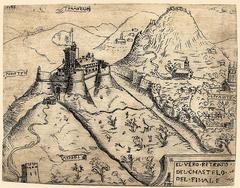Torre Di Belenda: Visiting Hours, Tickets, and Historical Significance in Finale Ligure, Italy
Date: 14/06/2025
Introduction
Torre di Belenda, also known as Torre Giannuzzi, towers above the eastern slopes of San Bernardino hill in Finale Ligure, Liguria. This distinguished medieval watchtower, built between the late 13th and early 14th centuries, offers travelers a tangible connection to the region’s feudal heritage and vast coastal vistas. Originally constructed for the influential Del Carretto family, the tower’s robust stonework, strategic location, and evocative legends make it a must-see historical site. Whether you are an enthusiast of medieval architecture, a lover of panoramic landscapes, or a curious explorer, Torre di Belenda is a focal point for understanding and experiencing Finale Ligure’s layered history.
This guide presents a comprehensive overview of Torre di Belenda, including its historical background, architectural features, visiting hours, ticket information, accessibility, nearby attractions, and practical travel advice. You’ll also find answers to frequently asked questions and resources to help plan your visit (MUDI Finale, Mondi Medievali, Visit Finale Ligure).
Historical Background
Origins and Strategic Role
Torre di Belenda’s origins are rooted in a period of regional consolidation and defense, when the Del Carretto family controlled the Finale area. Built atop remnants of prior structures, the tower was both a fortified residence and a lookout, critical for monitoring the approaches to the marquisate’s administrative center in Finalborgo. Its elevated position above Val Sciusa enabled surveillance against Saracen pirate raids and rival feudal threats, while its construction from local Pietra di Finale limestone exemplifies the resourcefulness of Ligurian builders (MUDI Finale, Mondi Medievali).
Architectural Features
The tower’s architecture is emblematic of Ligurian medieval military design: a rectangular plan, thick load-bearing walls over a meter wide, and minimal decorative flourishes. Defensive features include small slit windows for archers, a monolithic arched portal, barrel-vaulted chambers, and evidence of former wooden balconies. The ground floor was likely used for storage and as a refuge, while upper levels housed living quarters. The roof and upper floors are partially collapsed, but corbels and stonework remain visible, offering insight into the daily life and defensive needs of its inhabitants (MUDI Finale).
Cultural Significance and Legends
Beyond its military function, Torre di Belenda is woven into local folklore. The most enduring legend tells of a young woman, Belenda, who perished in the tower, giving the site its evocative name. Such stories reinforce the tower’s role as both a symbol of community resilience and a living link to Finale Ligure’s past (Mondi Medievali).
Visiting Information
Opening Hours & Tickets
- Visiting Hours: Torre di Belenda is typically open to the public daily from 9:00 AM to 6:00 PM, with longer hours during summer months. Since the site is unstaffed and open-air, visitors can access it at any time, though daytime visits are recommended for safety and visibility.
- Tickets: No admission fee is required for individual visits. Guided tours, when available, may require advance booking and a nominal fee. For tour schedules, check with the Finale Ligure Tourist Information Office.
Accessibility
The tower is reachable via hiking trails from Finalborgo or local parking areas. Trails are uneven and moderately steep; sturdy footwear and reasonable fitness are recommended. Due to its historic construction and hillside location, the site is not accessible for wheelchairs or those with significant mobility impairments.
Directions & Parking
Starting points for the walk include the historic center of Finale Ligure or nearby hamlets. The hike usually takes 20 to 40 minutes. Some parking is available at trailheads, and local buses connect Finale Ligure with Finalborgo.
Facilities and Visitor Tips
- Amenities: There are no restrooms or refreshment facilities at the tower; bring water and snacks.
- Best Time to Visit: Spring and autumn offer the most comfortable weather and fewer crowds.
- Photography: Sunrise and sunset provide exceptional light for photographing the tower and its panoramic views.
- Respect the Site: Do not climb on the structure, remove stones, or leave litter.
Nearby Attractions
Extend your exploration with visits to:
- Castel Gavone: The grand Del Carretto fortress nearby.
- Finalborgo: A preserved medieval village with restaurants and shops.
- Archaeological Museum of Finale: Exhibiting local history from prehistory through the Renaissance.
- Hiking and Outdoor Activities: Finale Ligure is renowned for its trails, climbing routes, and cycling paths.
(Visit Finale Ligure: Things to Do)
Events and Community Engagement
Torre di Belenda is featured in local festivals, historical reenactments, and educational programs, often organized in collaboration with schools and community groups. While regular events are rare due to its preservation status, special occasions may include guided walks or open-air performances. For the latest event information, consult local tourism resources (Visit Finale Ligure).
Frequently Asked Questions (FAQ)
Q: What are the Torre di Belenda visiting hours?
A: The site is open to visitors daily, generally from 9:00 AM to 6:00 PM, with longer hours in summer.
Q: Is there an admission fee?
A: No, visiting the exterior is free of charge.
Q: Are guided tours available?
A: Occasionally, during special events or by prior arrangement through the tourist office.
Q: Is the site accessible for wheelchairs?
A: No, the trails are not suitable for wheelchairs or strollers.
Q: Can I bring pets?
A: Yes, but keep them on a leash and supervise them closely.
Visuals and Media
Interactive maps, virtual tours, and additional photo galleries are available via local tourism websites and the Visit Finale Ligure cultural routes.
Enhance Your Visit
- Combine Sites: Pair Torre di Belenda with Castel Gavone and Finalborgo for a full day of historical exploration.
- Use Digital Resources: Download the Audiala mobile app for up-to-date tour information and self-guided audio experiences.
- Support Local Businesses: Enjoy a meal or coffee in Finale Ligure’s historic center before or after your visit.
- Share Your Experience: Post your photos online to promote awareness of this unique site.
Conclusion
Torre di Belenda stands as a resilient emblem of Finale Ligure’s medieval past—its stone walls and panoramic views inviting visitors to step into a world shaped by feudal ambition, strategic ingenuity, and enduring community spirit. Open-access policies and informative resources ensure that all who visit can appreciate both its historical importance and its role in the living culture of Liguria.
For further information, ticket details, and digital resources, visit the official tourism sites and download the Audiala app to enhance your journey.
References
- MUDI Finale
- Mondi Medievali
- Visit Finale Ligure
- TripHobo: Torre di Belenda
- Finale Ligure Historical Archive

